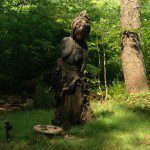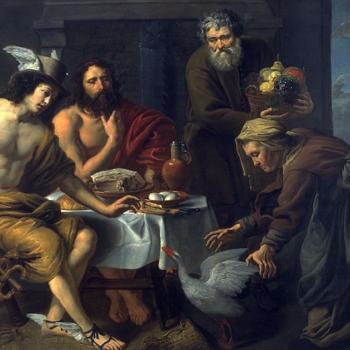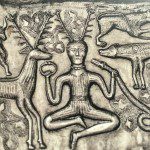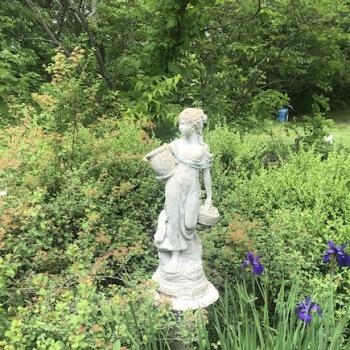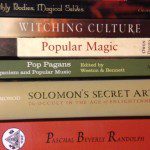 (As I’ve grown as a Pagan and changed as a person, the types of “Pagan reading” I like to engage in have changed as well. Like most individuals starting out on the Pagan Path I initially read a lot of beginner material from Llewellyn along with a lot of other popular titles generally found at the mall. Over the last ten years or so I’ve gravitated more towards academic works, especially those dealing with early Modern Paganism and the Western Magical Tradition (I’ve also got a soft spot for Capall Bann Publishing, they release a lot of great titles!). Scholarly stuff is not for everyone, but can be well worth the effort when you are extremely interested in a particular subject and want to go a bit deeper than most.)
(As I’ve grown as a Pagan and changed as a person, the types of “Pagan reading” I like to engage in have changed as well. Like most individuals starting out on the Pagan Path I initially read a lot of beginner material from Llewellyn along with a lot of other popular titles generally found at the mall. Over the last ten years or so I’ve gravitated more towards academic works, especially those dealing with early Modern Paganism and the Western Magical Tradition (I’ve also got a soft spot for Capall Bann Publishing, they release a lot of great titles!). Scholarly stuff is not for everyone, but can be well worth the effort when you are extremely interested in a particular subject and want to go a bit deeper than most.)
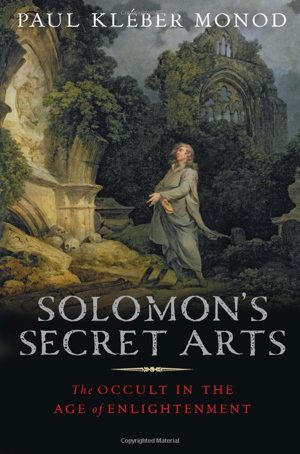 The Seventeenth and Eighteenth Centuries are not generally seen as “sexy” when it comes to magical practices. The Nineteenth Century kicked off the Modern Pagan Revival, and the Renaissance reintroduced (high) magic and the “old gods” to Europe. Due to those factors, magic during the period of the English Enlightenment is often overlooked. Thankfully that’s all been rectified by Solomon’s Secret Arts: The Occult in the Age of Enlightenment by by Paul Kleber Monod (Yale University Press, May 2013). While Monod’s book is not as comprehensive as I might have liked (there’s not a lot of material on practices outside of urban areas for instance), there’s still a lot of great material here. It’s one of those volumes I didn’t know I needed until I finished reading it.
The Seventeenth and Eighteenth Centuries are not generally seen as “sexy” when it comes to magical practices. The Nineteenth Century kicked off the Modern Pagan Revival, and the Renaissance reintroduced (high) magic and the “old gods” to Europe. Due to those factors, magic during the period of the English Enlightenment is often overlooked. Thankfully that’s all been rectified by Solomon’s Secret Arts: The Occult in the Age of Enlightenment by by Paul Kleber Monod (Yale University Press, May 2013). While Monod’s book is not as comprehensive as I might have liked (there’s not a lot of material on practices outside of urban areas for instance), there’s still a lot of great material here. It’s one of those volumes I didn’t know I needed until I finished reading it.
Of particular interest to me were the sections dealing with alternative and secret Masonic rites and degrees, many of which had alleged ancient pagan pedigrees. As my own studies into history continue, I’ll be curious to see if any of those practices had a direct influence on Modern Paganism. (Would I have been interested in being an initiate of the mostly bogus Egyptian Rite in 1786? Most certainly!) In addition to the sections on Freemasonry, Monod does a great job of articulating the scientific establishment’s interest in magic, and then chronicling when the two sides mostly go their separate ways. I was also astonished by the sheer number of people who were interested in astrology in Eighteenth Century England.
Most modern history books overlook just how important magic and other occult practices were centuries ago. To ignore such things is to ignore just how creative and intellectually curious our ancestors were. Knowing that people wrestled with the concept of Neoplatonism in the Seventeenth Century makes me feel better about our past. Couple that with the knowledge that great thinkers like Sir Issac Newton had more than a passing interest in occult theory and you’ve got me thinking that Modern Paganism (a flowering of the Western Magical Tradition) has an even more distinguished pedigree than I ever could have imagined. Monod’s book is a “must have” for anyone interested in astrology, alchemy, or the history of magic. This is one I’ll be turning to time and time again over the next couple of decades.
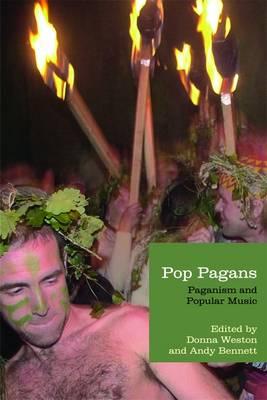 Perhaps I live too close to the source material, or maybe my expectations were overly high, but I’ll admit to being mildly disappointed by Pop Pagans: Paganism and Popular Music (Studies in Contemporary and Historical Paganism) edited by Donna Weston and Andy Bennett (Acumen Publishing, May 2013). I’ve always found academic anthologies to be a mixed bag. Sometimes individual articles live up to the title of the book, and other times they are only tangentially related. Some articles become vital research material, and others feel as if they are just taking up space. I sympathize with the editors because they can only publish what’s submitted to them, but I just felt as if there were so many more stories to tell on the subject articulated by the book’s title.
Perhaps I live too close to the source material, or maybe my expectations were overly high, but I’ll admit to being mildly disappointed by Pop Pagans: Paganism and Popular Music (Studies in Contemporary and Historical Paganism) edited by Donna Weston and Andy Bennett (Acumen Publishing, May 2013). I’ve always found academic anthologies to be a mixed bag. Sometimes individual articles live up to the title of the book, and other times they are only tangentially related. Some articles become vital research material, and others feel as if they are just taking up space. I sympathize with the editors because they can only publish what’s submitted to them, but I just felt as if there were so many more stories to tell on the subject articulated by the book’s title.
With a title like Pop Pagans I expected information on songs like Hymn to Her by The Pretenders or more than just a couple of sentences on the band XTC. And nothing on Julian Cope or Graham Bond? I found many of these omissions completely perplexing. Hopefully we’ll get a second volume that will include some of these things.
Despite my criticisms there are some really excellent articles in Pop Pagans. Jason Pitzl-Waters’ “The Darker Shade of Pagan” had me taking notes, looking up bands, and downloading music (I admit it, I’m listening to Inkubus Sukkubus as I right this). In just fourteen pages Jason had me angry at myself for overlooking Pagan-goth music while at the same time making me feel well versed in it. Deena Wenstein’s “Pagan Metal” was equally interesting (though a lot more familiar), and also had me looking up bands and contemplating future articles on RtH. It was nice to see Led Zeppelin pop up on several occasions, most notably in an article on “Paganism and the Counter-Culture” by (editor) Andy Bennett and again in (editor) Donna Weston’s “Rememberings of a Pagan Past.” (Good to know that I’m not the only one who thinks Led Zeppelin is important in this context.)
Word of caution, Pop Pagans is not always an easy read, and it embraces a wide range of disciplines. Since every chapter in the book is of a “stand alone” nature, each author has to spend several pages explaining how they define certain words. For readers of academic work, this is pretty standard stuff, but it can also be a bit tedious, especially for the lay reader. I don’t mean to sound so completely negative, there is some great work in this volume. For the student or fan of Pagan Music it’s definitely worth picking up, and at only thirty dollars (list price) it’s reasonably priced for an academic work. It can also be difficult to evaluate a work of this nature because it’s likely that articles I found less than scintillating will hold more interest to me in the future. Jason’s article on Goth Music alone is worth ten dollars, so while this may not be the most enthusiastic review ever, you will get your money’s worth.
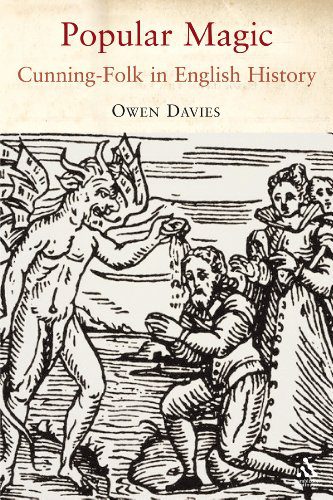 Owen Davies is rapidly becoming one of my favorite writers (and scholars) of the occult and the Western Magical Tradition. Grimoires: A History of Magic Books has been a favorite of mine the last couple of years. Even more enjoyable is 2003’s Popular Magic: Cunning-folk in English History (Continuum, published in August 2007). Davies is the rare academic who can write for the academy while also crafting a narrative easily understood (and devoured) by the lay reader. Popular Magic reads like a popular volume, but doesn’t skimp on detail or context. I really loved this book.
Owen Davies is rapidly becoming one of my favorite writers (and scholars) of the occult and the Western Magical Tradition. Grimoires: A History of Magic Books has been a favorite of mine the last couple of years. Even more enjoyable is 2003’s Popular Magic: Cunning-folk in English History (Continuum, published in August 2007). Davies is the rare academic who can write for the academy while also crafting a narrative easily understood (and devoured) by the lay reader. Popular Magic reads like a popular volume, but doesn’t skimp on detail or context. I really loved this book.
Unlike more popular treatments of cunning-folk Davies doesn’t romanticize. He presents the cunning-folk as they were, practitioners capable of great deception along with incredible acts of empathy and skill (as he points out, visiting a cunning-man was just as effective as visiting a doctor, if not more so, for several centuries). Davies paints a picture of cunning-folk as literate tradespeople, a picture often at odds with popular images of cunning-folk as rural illiterates. He also writes about them as a class of magicians who bridged the gap between more rustic practices and the high magic of the grimoire tradition.
Instead of a chronological history of cunning-folk Davies’ book is divided into chapters dealing with certain practices and attributes. It’s a bit jarring in places to go from an example in 1615 to one in 1857 but somehow he makes it all work. Though not one of the book’s goals, it’s interesting to read how the word “witch” has been used over the centuries. As a student of Modern Paganism the last chapter dealing with cunning-folk in the Twentieth Century was of particular interest. I can’t say enough good things about this book, put it on your short-list now.
Happy Reading!


